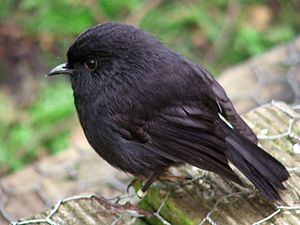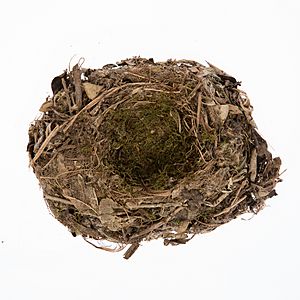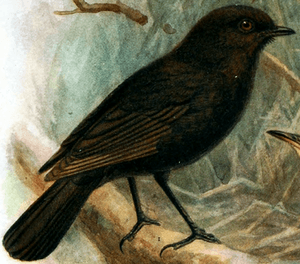Black robin facts for kids
Quick facts for kids Black robin |
|
|---|---|
 |
|
| Conservation status | |
| Scientific classification |
The black robin or Chatham Island robin (Petroica traversi) is a small, endangered bird. It lives only on the Chatham Islands, which are off the east coast of New Zealand. This bird is closely related to the South Island robin.
Walter Buller first described the black robin in 1872. Its scientific name, Petroica traversi, honors Henry H. Travers, a New Zealand botanist. In the Māori language, it is called kakaruia. In the Moriori dialect, it is called karure.
Unlike other robins, the black robin does not fly long distances. Because it evolved without many predators, it was very vulnerable to new animals like cats and rats. These animals were brought to the islands by humans. The black robin disappeared from the main Chatham Island before 1871. After that, it only lived on Little Mangere Island.
Contents
Discovery of the Black Robin
The black robin was first mentioned in science in 1871. William Travers shared information from his son, Henry Travers. Henry had visited the Chatham Islands to study the animals there.
Henry Travers' notes were published in 1872. However, Walter Buller published his own description a month later. Buller's publication is seen as the official discovery of the species.
What Does a Black Robin Look Like?
The black robin is a small bird, about the size of a house sparrow. It measures about 10 to 15 centimeters (4 to 6 inches) long. Its feathers are almost entirely brownish-black. It has a black beak and brownish-black feet with yellow soles.
Female black robins are usually a bit smaller than males. Male robins sing a simple song with 5 to 7 notes. Their call is a single, high-pitched sound. Their eyes are dark brown. Black robins shed their old feathers and grow new ones between December and March.
Where Do Black Robins Live?
Black robins live in the remaining low-lying scrub forests. They eat only insects. They find their food on the forest floor or on low branches. They like to build their nests in hollow trees and tree stumps.
The islands have strong winds and rough seas. To stay safe, black robins spend a lot of time in the lower parts of the forest. They also like flat areas with thick layers of fallen leaves. They often visit woody plants under the cover of trees like akeake.
How Black Robins Live
Black robins are very territorial. This means they protect their own space. Male robins will patrol and defend their areas. Female robins have also been seen chasing away other females. They make short flights from branch to branch and do not fly long distances.
What Do Black Robins Eat?
Black robins search for food in the leaf litter on the ground. They look for grubs, cockroaches, wētā, and worms. They can hunt for food both during the day and at night. They have good night vision to help them see in the dark.
How Black Robins Breed
Black robins usually start to breed when they are two years old. The female robin builds the nest. While she lays and keeps the eggs warm, the male feeds her so she can rest.
Eggs are laid between early October and late December. If the first set of eggs does not hatch, the female might lay a second set. They usually lay one to three eggs, but two is most common. The eggs are creamy in color with purple spots. The female sits on the eggs for about 18 days until they hatch. After the chicks hatch, both parents help to feed them.
Young robins stay in the nest for about 23 days. Even after they leave the nest, their parents continue to feed them until they are about 65 days old. This is a longer time than most birds of their size. After leaving the nest, young chicks often spend a day or two on the ground. Here, they learn to use their wings. This time on the ground can make them easy targets for predators.
How Long Do Black Robins Live?
From 1980 to 1991, black robins lived for about four years on average. "Old Blue", who was the only female able to have babies in 1980, lived for over 14 years! Some black robins can live from 6 to 13 years.
Saving the Black Robin
Today, there are about 250 black robins. But in 1980, only five were left on Little Mangere Island. They were saved from extinction by Don Merton and his Wildlife Service team. "Old Blue," the last female who could have babies, was key to their survival.
The remaining birds were moved to Mangere Island. The team helped "Old Blue" (and later other females) have more chicks each year. They did this by taking the first set of eggs and placing them in the nest of a different bird, the Chatham race of the tomtit. This method is called cross-fostering. The tomtits raised the first group of chicks. Because the black robins lost their eggs, they laid another set and raised those chicks themselves.

Many female robins used to lay their eggs on the edge of the nest. These eggs could not survive without help. Human conservationists carefully pushed the eggs back into the nests. There, the eggs were kept warm and hatched successfully. This behavior of laying eggs on the rim spread among the robins. At one point, over 50% of females laid eggs this way.
To prevent the birds from becoming too dependent on humans, the conservationists stopped pushing the eggs back. After this, rim laying became less common. By 2011, about 9% of birds still laid rim eggs. Some people worried that helping too much might cause problems for the birds in the long run.
All black robins alive today are descended from "Old Blue." This means there is not much genetic difference among them. This is called a population bottleneck. However, this has not caused problems from inbreeding. Scientists think the species might have gone through similar population drops before. This means they might have lost any genes that could cause problems from inbreeding.
It was once thought that a species needed about 50 individuals to avoid problems from inbreeding. But now we know this number can be much smaller for small island species like the black robin.
Common starlings sometimes attack black robin nests on Rangatira Island. This is the most common reason why nests fail, with almost 21% of nests failing because of starlings. This happens more often when black robins nest in holes rather than in open nests.
The black robin is still an endangered species. But its numbers are now around 250 birds. They live on Mangere Island and South East Island. Work is ongoing to restore their habitat and remove introduced predators. This will help the black robin population grow and spread to more areas. This reduces the risk of extinction from natural disasters or other unexpected events.
See also
 In Spanish: Petroica de las Chatham para niños
In Spanish: Petroica de las Chatham para niños




